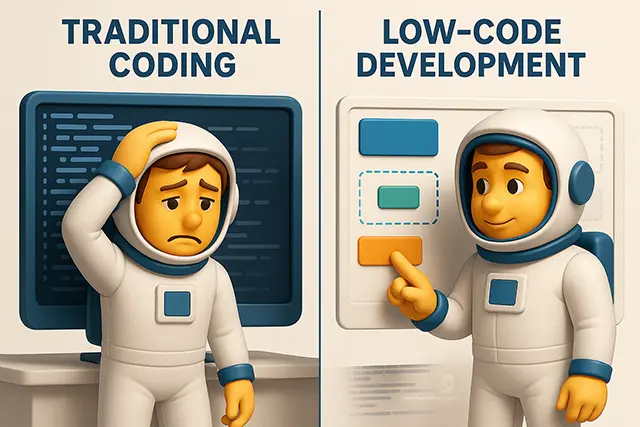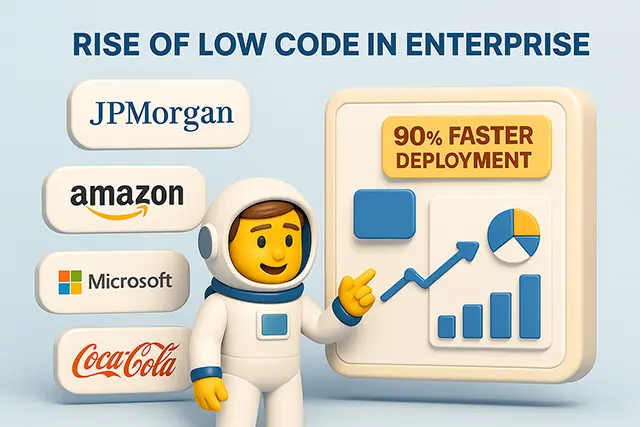Low Code Development Revolution Will Replace Traditional Programming

Last week, I watched a marketing manager at a Fortune company build a complete inventory tracking system in three hours. Three. Hours. No coding bootcamp, no CS degree just drag, drop, and deploy. Meanwhile, I spent half my career writing CRUD apps that took months to deliver.
The surprising part is this, the low code market is hitting $65 billion, and 70% of new applications will be built using low code or no-code platforms. That’s not a typo. Traditional developers in Silicon Valley are watching citizen developers build complex applications in days, not months. Companies like JPMorgan Chase and Liberty Mutual are already deploying hundreds of apps through visual programming interfaces.
But before you panic about your coding job becoming obsolete, let’s dive into what this revolution really means for American developers, why enterprises are betting big on drag-drop development, and how you can ride this wave instead of getting swept away by it.
Table of Contents
The Rise of Low Code Development in American Enterprise
Why Fortune 500 Companies Are Abandoning Traditional Coding
The numbers don’t lie. When Coca-Cola reduced their app development time by 90% using low code platforms, the entire industry took notice. American enterprises are facing a brutal reality: they need software faster than ever, but there aren’t enough developers to go around. The US Bureau of Labor Statistics projects 1.2 million unfilled developer positions by 2026.
Enter low code development the hero nobody asked for but everybody needs. Companies like Home Depot and FedEx have deployed hundreds of internal applications using these platforms, slashing development costs by up to 70%. The business logic that once required months of coding now gets configured through intuitive visual interfaces.
The Real Cost Savings Behind No-Code Platforms
When it comes to budgets, there’s a clear winner. Traditional app development costs American companies an average of $270,000 per application. Low code? That drops to around $50,000. When you’re building dozens of applications annually, we’re talking millions in savings.
But here’s where it gets interesting: the real savings come from maintenance. No-code platforms handle updates, security patches, and infrastructure scaling automatically. Your IT department stops firefighting and starts innovating. Companies report 60% reduction in maintenance costs after switching to low code solutions.
Citizen Developers: The New Workforce Revolution
Remember when only programmers could build software? Those gatekeeping days are over. Citizen developers business users who create applications without formal coding training are exploding across American corporations. According to Gartner’s latest research, by 2025, citizen developers will outnumber professional developers 4:1.
At companies like Progressive Insurance, marketing teams build their own campaign management tools. HR departments create employee onboarding workflows. Sales teams design custom CRM extensions. All without writing a single line of traditional code. This democratization of app development is reshaping how American businesses operate.
Visual Programming vs Traditional Development: The Technical Breakdown
How Drag-Drop Development Actually Works Under the Hood
Let’s demystify the magic. Low code platforms aren’t eliminating code they’re abstracting it. When you drag a button onto a canvas, the platform generates React components, API endpoints, and database schemas behind the scenes. Here’s a simplified example:
const CustomButton = ({ onClick, label, style }) => {
return (
<Button
variant="contained"
color="primary"
onClick={handleBusinessLogic}
style={style}
>
{label}
</Button>
);
};
// Automatic API generation
app.post('/api/workflow/trigger', async (req, res) => {
const { workflowId, params } = req.body;
const result = await WorkflowEngine.execute(workflowId, params);
res.json({ success: true, data: result });
});
The platform handles state management, authentication, database connections, and deployment pipelines. Citizen developers focus on business logic while the heavy lifting happens automatically.
Performance Implications of Low Code Applications
Here’s the elephant in the room: do low code applications perform as well as hand-coded solutions? The answer might surprise you. Modern no-code platforms like OutSystems and Mendix generate optimized code that often outperforms junior developer work.
These platforms implement best practices by default caching strategies, lazy loading, efficient database queries. They’re built by teams of expert engineers who’ve solved performance problems thousands of times. The generated code follows patterns that many developers would struggle to implement correctly.
However, for ultra-high-performance scenarios think Netflix’s video streaming algorithms or Uber’s real-time routing traditional development still wins. Developers working on these systems often prefer languages like Rust for its performance and memory safety benefits. But for 80% of business applications? Low code development delivers enterprise-grade performance.
Integration Capabilities with Existing Tech Stacks
The real test of any development platform is how well it plays with others. American enterprises have invested billions in existing systems SAP, Salesforce, Oracle, Microsoft. Low code platforms have evolved to become integration powerhouses, aligning perfectly with the modern API-first approach that’s revolutionizing tech stacks.
// Example: Integrating with Salesforce in a low-code platform
const salesforceConnector = {
authenticate: async () => {
return await OAuth2.connect({
clientId: process.env.SF_CLIENT_ID,
clientSecret: process.env.SF_CLIENT_SECRET,
redirectUri: 'https://app.company.com/callback'
});
},
createLead: async (leadData) => {
const sf = await salesforceConnector.authenticate();
return await sf.sobject('Lead').create({
FirstName: leadData.firstName,
LastName: leadData.lastName,
Company: leadData.company,
Email: leadData.email
});
}
};
// In low-code: This becomes a simple drag-drop "Create Salesforce Lead" action

Building Enterprise Applications with Rapid Application Development
Case Study: How American Airlines Transformed Operations
American Airlines faced a crisis: they needed 75 new applications to support COVID-19 safety protocols. Traditional development would take 18 months. Using low code development, they deployed all applications in just 10 weeks.
Their contact tracing app, built by a team of citizen developers from operations (not IT), processed over 100,000 employee health checks daily. The rapid application development approach saved an estimated $4.2 million while potentially saving lives.
Workflow Automation Success Stories from Silicon Valley
In San Francisco’s competitive tech scene, startups are using no-code platforms to achieve what previously required million-dollar development budgets. Take Notion they built their initial MVP using low code tools before transitioning to custom development after securing funding.
But it’s not just startups. Google uses AppSheet which they acquired for internal workflow automation. Employees create custom applications for expense tracking, meeting scheduling, and project management without involving engineering teams. This freed up over 10,000 developer hours annually for core product development.
Digital Transformation Through Business Process Automation
The pandemic accelerated digital transformation by a decade. Companies that survived were those that adapted quickly. Low code development became the secret weapon for rapid digitization.
Wells Fargo used drag-drop development to digitize loan applications, reducing processing time from weeks to hours. The visual programming interface allowed business analysts to map existing processes directly into digital workflows. No translation between business requirements and technical specifications what you see is what you get.
The Future of App Development in the American Job Market
Impact on Developer Salaries and Career Paths
will low code development kill programming jobs? The data says no but it’s complicated. Traditional developer salaries in the US average $107,000. Low code developers? They’re earning $95,000. Not bad for “not real programming,” right?
The twist: demand for both is skyrocketing. Companies need traditional developers to build the complex, custom functionality that low code can’t handle. They’re also leveraging AI coding tools like GitHub Copilot to boost productivity in traditional development. Meanwhile, they need low code specialists to rapidly deliver business applications. Smart developers are learning both, commanding salaries of $130,000+.
New Skills Required for the Low Code Era
The most successful developers won’t be code purists they’ll be solution architects. Understanding when to use low code versus traditional development becomes a superpower. Key skills include:
- Business process analysis and optimization
- API design and integration architecture
- Security and compliance for automated systems
- Performance optimization for generated code
- Hybrid development strategies
Austin’s tech scene is already seeing this shift. Companies value developers who can prototype in low code, then optimize critical components with custom code. It’s not either/or it’s both/and.
Enterprise Automation Job Opportunities
The job market is exploding with new roles, Low Code Architect $140,000, Citizen Developer Program Manager $125,000, Automation Strategy Consultant $150,000. These positions didn’t exist five years ago. Now they’re some of the highest-paid roles in tech.
Microsoft’s Power Platform alone has created over 500,000 jobs globally, with US companies leading adoption. Salesforce is hiring thousands for their low code ecosystem. Even traditional companies like Ford and Walmart are building massive low code development teams.
Application Lifecycle Management in the Low Code World
Governance and Security Considerations
With great power comes great responsibility. When everyone can build applications, governance becomes critical. Successful enterprises implement strict application lifecycle management protocols for their low code platforms.
Security isn’t optional it’s mandatory. Low code applications access the same sensitive data as traditional applications. Platforms now include:
// Built-in security features in low-code platforms
const securityConfig = {
authentication: {
type: 'OAuth2',
provider: 'AzureAD',
multiFactor: true
},
authorization: {
model: 'RBAC',
granularity: 'field-level'
},
encryption: {
atRest: 'AES-256',
inTransit: 'TLS 1.3'
},
compliance: ['HIPAA', 'SOC2', 'GDPR']
};
Scaling Custom Applications Across the Enterprise
The real test of low code development comes at scale. When JPMorgan Chase deployed their citizen developer program, they started with 10 applications. Today? Over 1,000 applications serving 250,000 employees.
Treating low code development like traditional development. Code reviews even for visual programming, testing protocols, deployment pipelines, monitoring all essential. The only difference is that business users participate directly in the process.
Version Control and Deployment Strategies
Modern no-code platforms have evolved beyond simple builders. They include:
- Git integration for version control
- CI/CD pipelines for automated deployment
- A/B testing capabilities
- Rollback mechanisms
- Environment management (dev/staging/production)
This maturity makes enterprise adoption feasible. You’re not giving up control you’re gaining speed.
Frequently Asked Questions
Will low code development completely replace traditional programming jobs in the US?
Not entirely. While low code development is transforming how we build business applications, complex systems still require traditional programming. Think of it like this: low code handles 80% of typical business needs, but that remaining 20% high-performance algorithms, system-level programming, specialized AI/ML models still needs experienced developers. The best career strategy? Learn both. US developers who master low code alongside traditional skills are commanding 20-30% higher salaries.
What are the limitations of no-code platforms for enterprise applications?
No-code platforms excel at standard business applications but hit walls with unique requirements. Performance-critical applications like real-time trading systems, complex algorithms, or highly customized user interfaces often require traditional coding. Most enterprises use a hybrid approach: low code for rapid development, custom code for special requirements. The key is knowing when to use which approach.
How much can American companies really save with low code development?
The numbers are compelling: 70% reduction in development time, 50-70% cost savings, and 60% less maintenance overhead. For a typical mid-size company building 20 applications annually, we’re talking $4-5 million in savings. But the real value? Speed to market. Companies launch new products and services months faster than competitors using traditional development.
Which low code platforms are most popular with US enterprises?
Microsoft Power Platform dominates with 35% market share, followed by Salesforce Lightning 20%, ServiceNow 15%, and OutSystems 10%. Each has strengths, Microsoft integrates seamlessly with Office 365, Salesforce excels at CRM-related apps, ServiceNow rules IT automation, and OutSystems handles complex enterprise applications. Most companies use multiple platforms for different needs.
Do citizen developers need any programming knowledge?
Basic logic understanding helps, but traditional programming knowledge isn’t required. Think Excel formulas rather than JavaScript. Most citizen developers come from business backgrounds they understand processes, not code. Successful programs include 2-3 weeks of training covering platform basics, best practices, and governance. The learning curve is surprisingly gentle.
How secure are applications built with low code development?
Enterprise low code platforms often provide better security than custom-built applications. They include authentication, encryption, and compliance features by default. Platforms undergo rigorous security audits and automatically patch vulnerabilities. The risk comes from citizen developers not following security best practices that’s why governance and training are crucial.
What’s the career path for developers interested in low code?
Start by getting certified in major platforms (Microsoft, Salesforce, ServiceNow). Build portfolio projects demonstrating business value. The career progression typically goes: Low Code Developer $85,000 → Low Code Architect $120,000 → Digital Transformation Lead $150,000+. The sweet spot? Combining low code expertise with traditional development skills and business acumen.
Conclusion
The low code development revolution isn’t coming it’s here, transforming how American businesses build software. With the market racing toward $65 billion and enterprises saving millions while accelerating innovation, ignoring this shift isn’t an option.
But here’s the real insight, low code development isn’t replacing traditional programming it’s elevating it. By handling routine application development through visual programming and drag-drop interfaces, we’re freeing skilled developers to tackle genuinely complex challenges. Citizen developers handle the 80% of standard business needs, while professional developers focus on the 20% that requires deep expertise.
For developers worried about their future, the message is clear embrace the change. Learn low code platforms, understand their strengths and limitations, and position yourself as a bridge between business and technology. The most valuable developers won’t be those who can code the fastest they’ll be those who can deliver solutions the smartest, whether through traditional code, no-code platforms, or most likely a combination of both.
The revolution isn’t about replacing developers. It’s about amplifying human potential through technology. And that’s a future worth coding for however we choose to do it.







